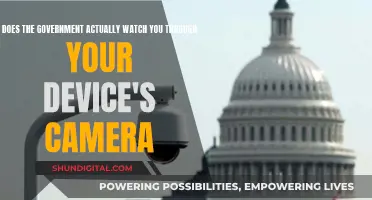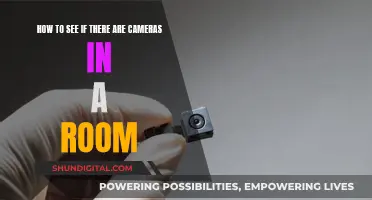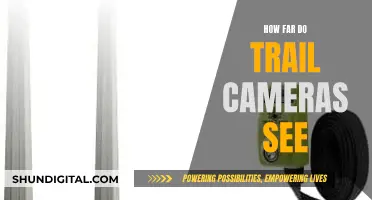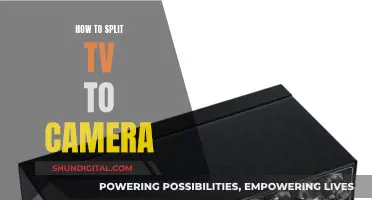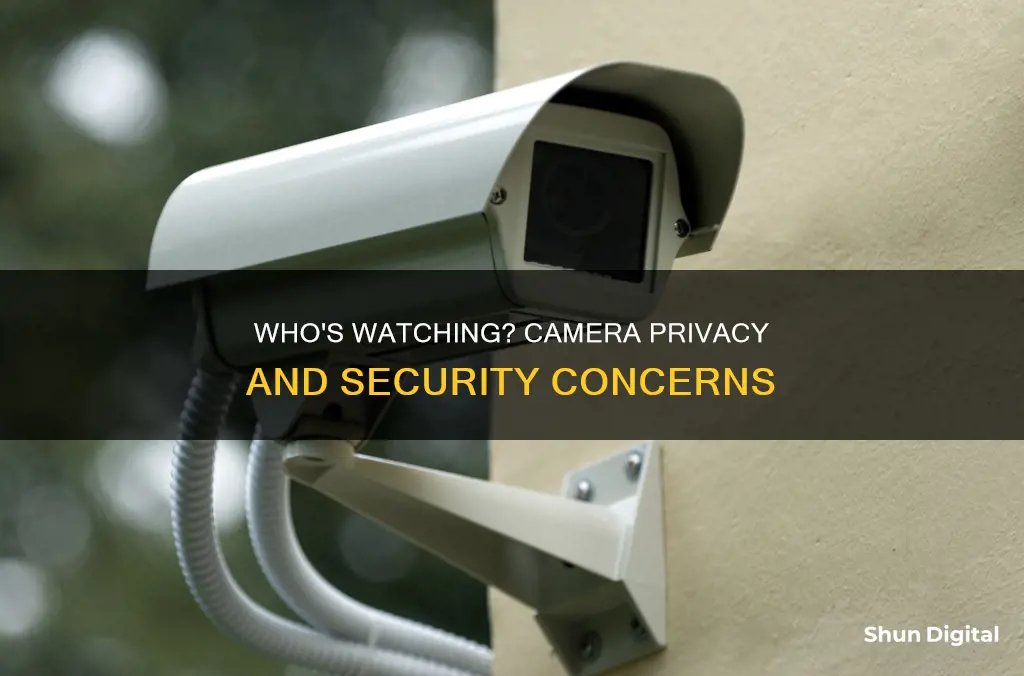
In the digital age, privacy and security are growing concerns for many. With the rise of video chatting and social media live streaming, your computer’s webcam is more relevant than ever. But are there people watching you through your computer camera? It is possible for hackers to take control of your webcam and turn it into a tool for spying and extortion. However, it's important to note that while this is a potential risk, it's not an easy feat for just anyone to access your camera without your knowledge. This article will explore the signs that indicate someone may be watching you through your webcam and provide tips on how to protect yourself from prying eyes.
| Characteristics | Values |
|---|---|
| How easy is it for someone to hack your computer camera? | It is surprisingly easy for hackers to take over your camera. In some cases, the malware could be installed before you even buy your computer. |
| How can you tell if someone is watching you? | A major clue is if the LED light next to your camera is on, even when you’re not using it. However, this signal can be disabled by an attacker. |
| What to do if you’ve been compromised? | Cover your camera with a plaster or something similar. Set up firewall rules to block audio and video traffic. Uninstall your webcam drivers, and run a complete scan of all of your drives using reputable anti-virus and anti-malware software. |
| How can you avoid this happening to you? | Cover your cameras when you’re not using them. Regularly update and patch devices, drivers and applications. Protect your system with a reliable layered security. |
| Who might be spying on you? | Organizations and individuals. Social media apps. Governments. Cybercriminals. Stalkers. Jealous ex-partners. |
| How can they spy on you? | Cybercriminals only need the right spyware and an entry point into your device, e.g. an outdated app, an infected link, or an unencrypted Wi-Fi connection. |
What You'll Learn

How to know if someone is watching you
It is possible for someone to watch you through your computer or phone camera. This is known as "camhacking" and it can be done by installing spyware or remote-access trojan malware. This allows hackers to turn your camera on and off, record, and save media from your camera roll.
- Check your data usage: Background apps use data to run tasks even when not in use. Malicious apps also run in the background, allowing hackers to monitor and record your activity. If your data allowance runs out faster than usual, this could be a sign that someone is watching you.
- Investigate your camera's behaviour: If your camera exhibits strange behaviour, such as third-party camera apps opening on their own, media in your gallery that you don't remember capturing, or your camera running slowly and crashing frequently, it could be a sign that someone is accessing your camera.
- Review your camera permissions: Check which apps have access to your camera and revoke permissions for any apps that you don't recognise or that don't need access to function properly.
- Monitor your video call performance: If you experience poor video call quality despite a good Wi-Fi connection and high data availability, it could indicate that someone is intercepting your calls.
- Listen for strange sounds in calls: If you hear odd sounds during your calls, such as a camera shutter, static, clicking, or echoes, it could mean that someone is listening to or recording your call.
- Review your location permissions: Location permissions allow apps to monitor your phone's movement and can reveal your home or work address. Review which apps have access to your location and remove access for any apps that don't need it.
- Monitor your camera light indicator: If the camera indicator light is on when you aren't using the camera or blinks abnormally, it could be a sign that someone is controlling your camera without your consent.
- Look for newly added apps, photos, or video files: Malware can hide in photo, video, and audio files. If you notice new files that you don't recognise or receive a ""low storage space" warning, it could indicate the presence of spyware.
- Assess your battery performance: If your battery loses power quickly without any apparent reason, it could be a sign of malware running in the background and draining your resources.
- Scan your device for spyware: Use a spyware detection tool such as Norton 360 Deluxe or Certo to scan your device for spyware and remove any threats.
It's important to note that while these signs may indicate the presence of spyware or camhacking, they could also be caused by other device or application issues. If you suspect that someone is watching you through your device, it's recommended to take proactive measures such as covering your camera with tape or using a virtual private network (VPN) to enhance your security and privacy.
Paranoia or Reality: FBI Surveillance via My Camera?
You may want to see also

Preventative measures
While it is unlikely that someone is watching you through your computer camera, it is still a possibility. Here are some measures you can take to prevent this from happening:
Use a Virtual Private Network (VPN)
Using a VPN can help keep hackers at bay by encrypting your internet traffic and masking your IP address. This makes it much harder for hackers to access your webcam.
Cover Your Webcam
A simple yet effective solution is to cover your webcam when not in use. You can use a piece of tape or a webcam cover that slides open and closed. This ensures that even if someone gains access to your camera, they cannot see anything.
Update Your Security Software
Keep your security software and operating system up to date. These updates often include patches for security vulnerabilities, which can help prevent webcam hacking.
Disable Your Camera
If you do not use your webcam frequently, consider disabling it altogether. This can be done through your device settings. By disabling the camera, you eliminate the possibility of unauthorized access.
Monitor Background Apps
Be vigilant about the applications running on your computer. Malware can be sneaked in as normal applications, especially if downloaded from unsecured websites. Regularly review your installed programs and remove anything suspicious or unfamiliar.
Use Secure Passwords
Strong and unique passwords are essential for protecting your devices and accounts. Avoid using easily guessable passwords and consider using a password manager to generate and store complex passwords. This makes it harder for hackers to gain access to your systems.
By following these preventative measures, you can significantly reduce the chances of someone watching you through your computer camera.
Candid Camera: Best Places to Watch the Show
You may want to see also

Spyware
- Data Usage: Spyware often runs in the background, consuming data and causing your cellular data allowance to deplete faster than usual.
- Camera Behaviour: Your camera may exhibit strange behaviour, such as third-party camera apps opening on their own, or media appearing in your gallery that you don't remember capturing.
- Camera Permissions: Review the permissions granted to apps on your device. If you find any illegitimate apps with camera access, revoke their permissions immediately.
- Video Call Performance: If your video calls are experiencing low quality or connection issues unexpectedly, it could indicate that someone is intercepting the call.
- Strange Sounds: During calls, be aware of odd sounds like camera shutter noises, static, clicking, or echoes, as these could indicate that your microphone is being accessed by a hacker.
- Location Permissions and Metadata: Spyware can access your location data and metadata from photos, revealing your home or work address. Review location permissions and remove access from any suspicious apps.
- Camera Light Indicator: If the camera light turns on unexpectedly or remains on after closing camera apps, it could be a sign of spyware or a hacked device.
- Newly Added Apps: Spyware can disguise itself as legitimate apps. Be cautious of downloading apps from unofficial sources, and regularly review and delete any apps you don't recognise or no longer need.
- Battery and Data Drain: Spyware running in the background can cause rapid battery drain and increased data usage.
- Device Overheating: If your device feels warmer than usual and none of the common causes apply, it could indicate spyware running in the background.
To protect yourself from spyware and webcam hacking, consider the following:
- Use a virtual private network (VPN) to enhance your online privacy and security.
- Cover your webcam with tape or a sliding cover when not in use.
- Be cautious when downloading apps and only download from trusted sources like official app stores.
- Strengthen your privacy settings by limiting app permissions, using strong passwords, and enabling two-factor authentication.
- Be vigilant for suspicious links, attachments, and phishing attempts, which are common methods for installing spyware.
- Install reputable security software and spyware scanners, such as Norton 360 Deluxe, to detect and block spyware.
B-Link Camera Security: Who's Watching via Web Browser?
You may want to see also

Social media apps and privacy
In today's digital age, social media platforms are an integral part of our lives, connecting us with people worldwide and fostering online communities. However, as our reliance on these platforms grows, so does the importance of safeguarding our privacy and personal information.
While it is challenging to completely prevent hacking attempts or data breaches, there are several measures and tools that users can employ to enhance their privacy and security on social media apps. Here are some essential strategies to consider:
Two-Factor Authentication (2FA)
Two-factor or multi-factor authentication adds an extra layer of security to your social media accounts. By requiring an additional verification step, such as a code sent to your mobile device, 2FA ensures that your account remains secure even if your password is compromised. This simple yet effective tool significantly bolsters your account security and is available on all major social media platforms.
Privacy Checkup Tools
Social media platforms provide built-in privacy tools within your profile settings. These tools empower you to manage your personal account data effectively. For instance, you can control which third-party apps have access to your data and decide what information advertisers can use for targeted ads. Each platform offers a unique set of tools tailored to its environment, such as Facebook's "Privacy Checkup" and Instagram's "Security Checkup."
Incognito/Ghost Mode
Incognito mode, also known as private browsing mode or ghost mode, enhances your privacy by minimising your digital footprints. This feature allows you to browse profiles and content without leaving a trace, ensuring your activities remain unseen by other users and the platform itself. For example, enabling "Ghost Mode" on Snapchat makes your location invisible to others.
Custom Audience Settings
Custom audience settings give you the power to control who can view and interact with your posts and stories. You can select options like 'Only Me', 'Friends', 'Connections', or create custom lists to keep sensitive content private. These settings are ideal for professionals who want to share content with colleagues without broadcasting it to their entire personal network.
Data Download and Deletion Tools
Data download and deletion tools offer transparency into the data collected by social media platforms. With these tools, you can download all the data the platform has saved on your profile, including liked posts and search history. Regularly reviewing this data allows you to delete any information you're uncomfortable with, reducing potential risks if that data were to fall into the wrong hands.
Choose Privacy-Conscious Platforms
When selecting a social media platform, consider those that prioritise user privacy and data security. For example, Signal, Telegram, and Keybase offer end-to-end encryption, ensuring that your messages and calls are protected and cannot be accessed by anyone except the intended recipients. Additionally, platforms like Diaspora are built on the principles of decentralisation, freedom, and privacy, allowing users to create and host their own servers or join existing ones, dispersing data ownership.
In conclusion, while social media apps bring us closer together, it's crucial to remain vigilant about our privacy. By utilising the tools mentioned above and choosing privacy-conscious platforms, you can better safeguard your personal information and enjoy a safer online experience.
Mobile Cameras and Solar Eclipse: Safe or Not?
You may want to see also

Government surveillance
Legal Authorities and Capabilities
Governments, including democratic ones, often possess the legal authority and technological capabilities to spy on their citizens through computer cameras and webcams. In the United States, for example, controversial laws like the USA PATRIOT ACT and FISA enable the collection of computer data, albeit with certain prerequisites. Additionally, governments may exploit security vulnerabilities in device software or operating systems to remotely access and activate cameras. This was highlighted by the revelations of Edward Snowden, a former NSA contractor, who exposed extensive surveillance programs by intelligence agencies.
Methods and Techniques
The methods employed by governments to spy on citizens through their computer cameras are diverse. They may include mass surveillance programs that collect and analyze data from various sources, such as websites, emails, and social media, to create profiles of private citizens. Governments can also partner with internet service providers (ISPs) to monitor web traffic and gain access to network infrastructure. Additionally, they may request user information, communications, and data from tech companies, although some may refuse or push back legally.
Signs of Surveillance
While it is unlikely that an individual is being directly targeted by government surveillance unless engaged in illegal activities or posing a threat to national security, there are some signs that may indicate potential monitoring. These include unusual surveillance activity near one's home or workplace, unexpected invites from people claiming to be government agents, and technical issues such as rapid battery drain or strange device behaviour. However, these signs could also indicate spying by cybercriminals rather than government entities.
Impact and Concerns
The impact of government surveillance through computer cameras and webcams raises concerns about privacy and civil liberties. Bulk data collection programs allow governments to acquire and analyze large amounts of metadata, providing insights into individuals' communications, relationships, and patterns of behaviour. Facial recognition technology further enhances their capabilities, enabling the creation of extensive databases for surveillance, law enforcement, and border protection. While supporters argue that surveillance helps maintain order and protect against threats, critics worry about the potential for mass surveillance and the infringement of civil rights.
Apple Watch: Camera Feature or Missing Component?
You may want to see also
Frequently asked questions
It is possible for someone to watch you through your computer camera, but it is unlikely unless your computer is provided by your company, you install unverified applications, or you are of interest to a government agency.
There are several signs that your computer camera has been compromised:
- The indicator light is on or blinking abnormally.
- The camera is moving or rotating without your command.
- Strange storage files appear, especially in your webcam recordings folder.
- Background apps or software that you don't recognise are running on your computer.
If you suspect that your computer camera has been compromised, you should:
- Cover your camera with a piece of tape or a webcam cover.
- Uninstall your webcam drivers and run a complete scan of your drives using reputable anti-virus and anti-malware software.
- Reinstall the drivers once your computer is rid of any malware.



